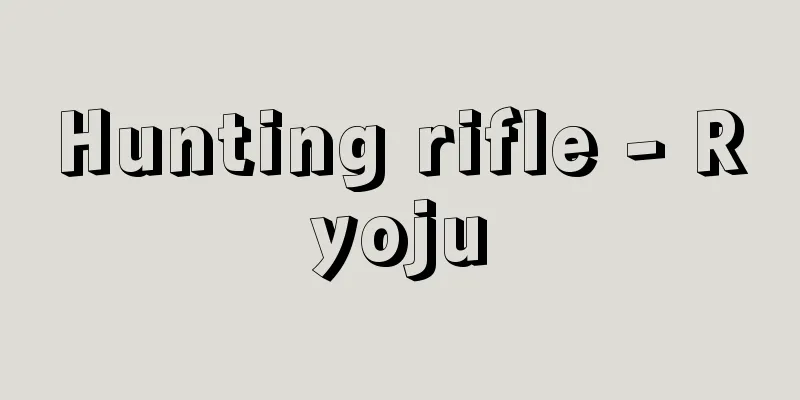Hunting rifle - Ryoju

|
Generally speaking, firearms for capturing birds and animals are classified into two types of firearms, powder guns and air guns (including compressed gas guns), as stipulated in the "Law Concerning the Protection and Management of Birds and Animals and the Rationalization of Hunting." Of these, only powder guns are called hunting guns. Powder guns fire bullets using the gas pressure generated by the explosion of gunpowder. There are shotguns, which mainly fire pellets and are intended for shooting birds and small to medium-sized animals, and rifles, which mainly fire a single bullet and are used to snipe bears, brown bears, wild boars, deer, etc., but the basic structure of both is the same. There are various types of loaded guns, and their use depends on the type of target prey, the environment of the hunting field, and the shooter's preferences. The most popular types of shotguns are the folding double-barreled gun and the autoloading gun, because they are easy to use. The most popular rifles are the bolt-loading repeating guns, because they are accurate, work well, and are sturdy, but in Japan, the bushings are well developed, so autoloading guns are also used quite often. The standard bore diameter (diameter 9 inches (approximately 229 mm) forward from the bottom of the case) for shotguns is 12. The most popular rifle is 300 caliber (300/1000 inches (approximately 7.62 mm)). Shotguns with a bore diameter of 10 or more and rifles with a bore diameter of 10.5 mm or more are considered too powerful and are generally prohibited from hunting. Rifles with a bore diameter of 5.9 mm or less are also prohibited from hunting. The barrel length is usually 26 to 30 inches (about 66 to 76.2 centimeters) for shotguns and 20 to 26 inches (about 50.8 to 66 centimeters) for rifles, and possession of anything with a barrel length of 19.25 inches (about 48.8 centimeters) or less is prohibited to prevent disguised possession. Incidentally, just because a firearm has a large caliber does not necessarily mean it has great power; its power is determined by the type and amount of powder, the weight and hardness of the bullet, etc. In order to possess a hunting rifle, a license from the Public Safety Commission is required, and those who hunt with loaded rifles must pass the "Type 1 Gun Hunting License" examination and be "registered as a hunter" with the prefecture. The main differences between hunting rifles and military or security rifles are: (1) the gun is well adapted to the user's physical condition and stamina, and can be handled as if it were a part of the user's body; (2) the accuracy and lethality, combined with the cartridges used, are sufficient for various types of target prey; and (3) the gun has an artistic element. Guns for target shooting have improved barrel, firing mechanism, and sight accuracy compared to actual hunting guns. Because they are so delicate, the safety and robustness of the sights are not sufficient for hunting wild animals in the mountains. Military guns and guns for shooting only are not permitted for hunting. [Kunihiko Shirai] [Reference] | | | | |Source: Shogakukan Encyclopedia Nipponica About Encyclopedia Nipponica Information | Legend |
|
一般に鳥獣捕獲用の銃器をさすが、「鳥獣の保護及び管理並びに狩猟の適正化に関する法律」で規定されている銃器には、装薬銃、空気銃(圧縮ガス銃を含む)の2種があり、このうち装薬銃だけを猟銃という。装薬銃は、火薬の爆発によって生ずるガスの圧力で弾丸を発射する銃器。主として散弾を発射して、鳥類や小中型獣類の射獲をおもな目的とする散弾銃と、主として単一の弾丸を発射して、クマ、ヒグマ、イノシシ、シカなどを狙撃(そげき)するライフル(銃)とがあるが、基本的な構造は両者同一。 装薬銃には種々の種類があり、目的の獲物の種類、猟野の環境、射手の好みなどで使い分けされる。散弾銃のうちもっとも普及しているのは、使いやすいという点から元折(もとおれ)式二連銃と自動装填(そうてん)銃の2種である。ライフルは精度と作動が堅確で、かつ堅牢(けんろう)であるという点で、遊底式連発銃がもっとも普及しているが、日本ではブッシュが発達しているため、自動装填式も少なからず使用されている。腔径(こうけい)(包底面から9インチ=約229ミリメートル前方の径)は、散弾銃では12番径が標準。ライフルは300口径(300/1000インチ=約7.62ミリメートル)がもっとも普及している。10番以上の大腔径の散弾銃と、10.5ミリメートル以上の大口径のライフルは威力が大きすぎるとされ、狩猟には原則使用禁止。また、口径5.9ミリメートル以下のライフルも狩猟での使用が禁止されている。銃身長は散弾銃では26~30インチ(約66~76.2センチメートル)、ライフルでは20~26インチ(約50.8~66センチメートル)が普通で、銃身長が19.25インチ(約48.8センチメートル)以下のものは、変装所持を防ぐため所持禁止。ちなみに、銃器は口径が大きいから威力が大であるとは限らず、装薬の種類や量と、弾丸の重量や硬度などによって威力が決定される。 猟銃を所持するには公安委員会の所持許可を要し、装薬銃で狩猟をする者は「第一種銃猟免許」試験に合格したうえ、都道府県の「狩猟者登録」が必要である。 猟銃が軍用銃や警備用銃と相違する主要点は、(1)銃が使用者個人の身体・体力などによく適合していて、自分の身体の一部のように扱えるものであること、(2)目的の各種獲物に対し、使用実包と相まって、命中精度と殺傷力が十分であること、(3)美術的要素を保有していること、などである。 標的射撃用の銃は、銃身と撃発機構と照準具の精度を実猟上の猟銃よりも向上させている。それだけデリケートにできているため、山野で飛鳥走獣を猟獲するには、安全性と照準具などの堅牢性が十分でない。なお軍用銃や射撃専用銃は狩猟用としての使用が許可されない。 [白井邦彦] [参照項目] | | | | |出典 小学館 日本大百科全書(ニッポニカ)日本大百科全書(ニッポニカ)について 情報 | 凡例 |
Recommend
ketose
...A general term for polyhydric alcohols with al...
Weishan Lake - Bisanko
A lake in the southern part of Shandong Province,...
Ari bin brode (English spelling) Aribinbrode
…A book that compiles records and anecdotes relat...
Varlamov, AE (English spelling)
...In the 19th century, this was consolidated int...
Prefecture - Agatai
〘 noun 〙① Living in the countryside. Country livin...
Wildlife protection area - chojuhogoku
Formerly known as no-hunting zones, no-hunting zo...
Meiji Shrine
Located in Yoyogi Jingu-cho, Shibuya-ku, Tokyo, i...
Ethylene series hydrocarbons - Ethylene series hydrocarbons
→Alkene Source: Asakura Publishing Nutrition and B...
Munch, Walter
Born October 19, 1917. Walter Heinrich Munk is an ...
sublingual gland
…The submaxillary gland is a plum-sized salivary ...
Minpen - Minpen
This refers to urban riots that occurred in China...
Tanden
〘Noun〙 In Chinese medicine, this refers to the are...
Tempera - Tempera (English spelling) Italian
One of the most traditional Western painting tech...
Chondrodendron platyphyllum (English name) Chondrodendronplatyphyllum
… [Susumu Terabayashi]. … *Some of the terminolog...
Humpbacked fly - Flea fly (English spelling)
A general term for insects belonging to the Dipter...









![Sujiyu [Hot Spring] - Sujiyu](/upload/images/67cbf498820ad.webp)